Thai Amulets: An Introduction
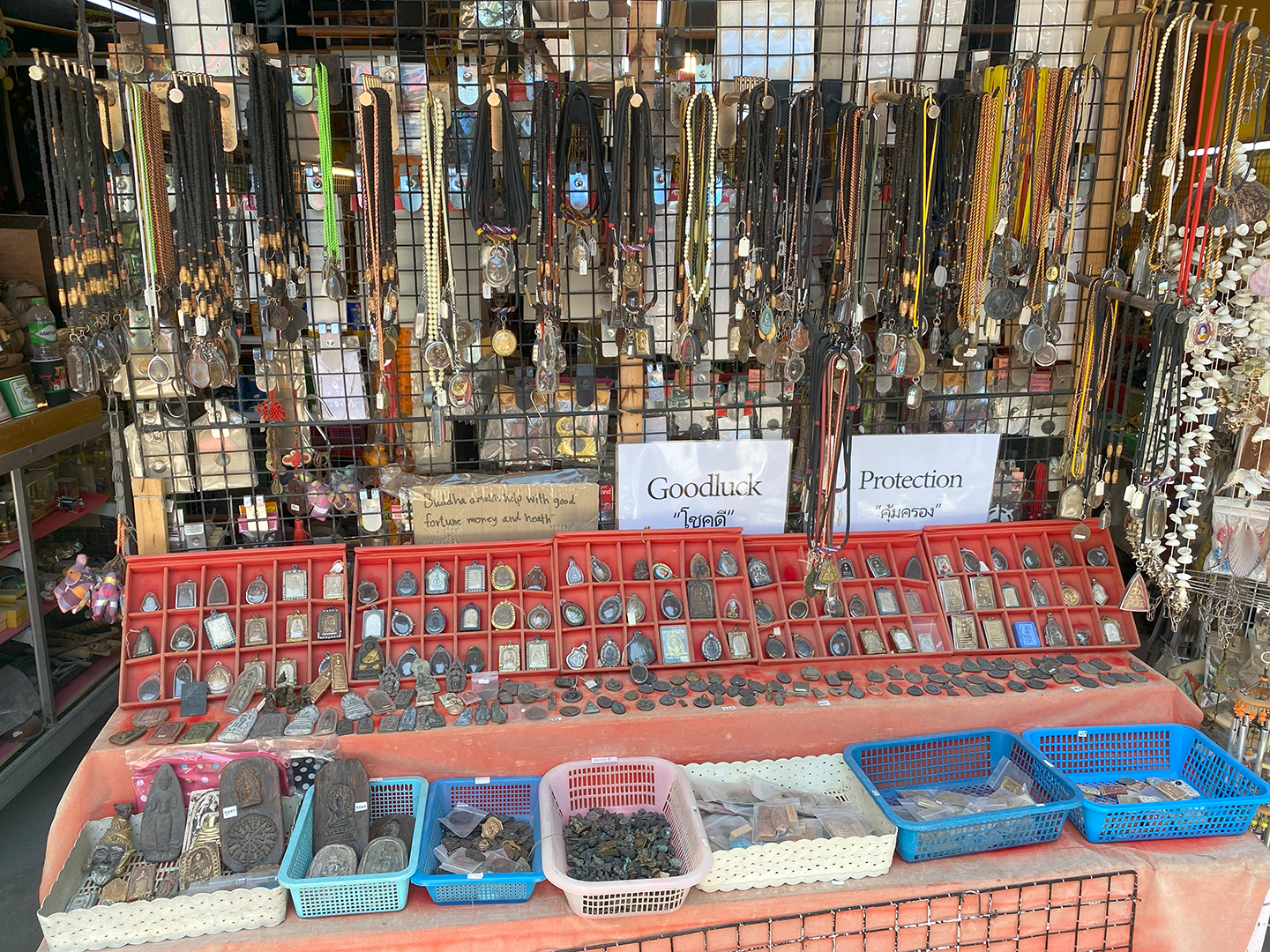
In any town or city in Thailand, often on the side of the road or in a mall, you will see men selling what appears to be exotic pendants, amulets, and jewelry. These are not your typical items you’d find back home, that you would buy because they look pretty or because it’s a fashion statement.
Instead, these Thai amulets (Phra Khrueang as they are known in Thai) have great spiritual significance and are worn for many different purposes. Some amulets, like Hanuman or a tiger, are meant to give the wearer increased strength and some amulets, like Klaew Klaad, give the wearer protection from danger.
Not only are amulets believed to have magical powers, but they are worn to honor renowned Buddhist teachers. For example, students and followers of Luang Pho Samrit will wear an amulet with his face etched into it.
The countless number of amulets, all the different styles and kinds, along with the frequency with which one can see them in any city or town in Thailand, illustrate their importance in Thai culture.
History
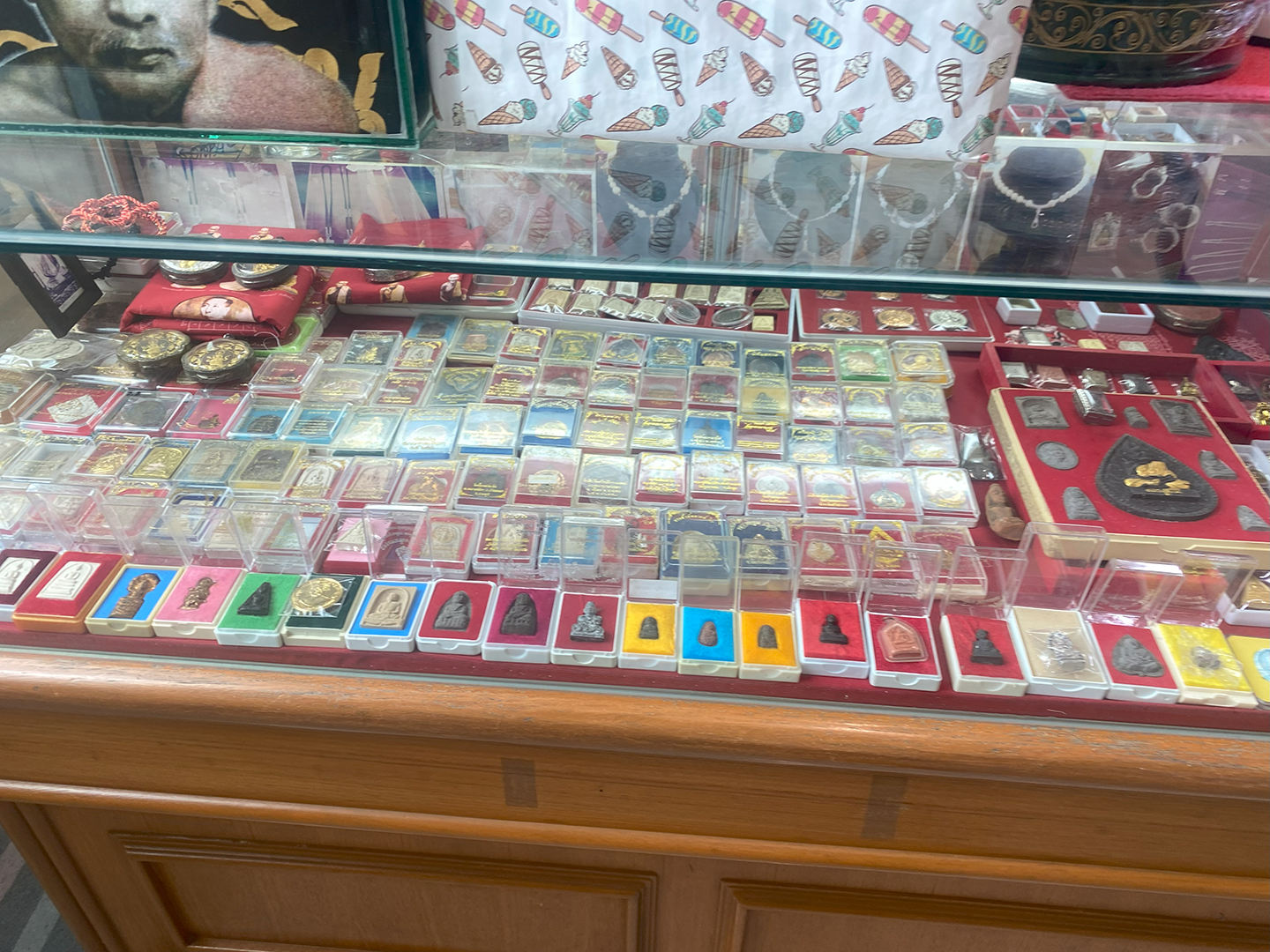
Looking at the history of Thai amulets, one might be surprised to find that their history is actually quite short. While buddha images and other spiritual images have been used by Thai people for hundreds and hundreds of years, for the majority of the time they were relegated to temples.
This is due to their sacredness. But at some point in the mid 19th century, Thais began engraving buddha images onto clay and wearing them in their daily life.

It must be clarified, that there are older versions of the modern Thai amulet (modern meaning from the mid 19th century until present day). The big distinction between modern Thai amulets and archaic Thai amulets is their appearance and their usage.
One of the oldest versions of the Thai amulet is called a “takrut”, and they date all the way back to the Sukhothai Period (13th-15th century AD) and usually consisted of metal or palm leaf rolled and inscribed with sacred texts or magical spells. They were carried specifically by soldiers as a means of protection. So you can see that the takrut’s appearance is different as well as its usage.
Modern Thai amulets are made from clay or metal and feature a revered figure. They are also worn by all people, not just soldiers.
Discovered in the mid 19th century, under the reign of King Chulalongkorn, the oldest version of the Thai amulet is known as Phra Rod. Though it is considered to be the first Phra Khrueang, for me it is a bit debatable. This amulet dates back to the 8th-10th century AD in what is now northern Thailand and it was during the Mon Empire. This predates what is considered to be the first Thai kingdom, Sukhothai, which was established in the 13th century AD.
Regardless, you can see the uncanny resemblance Phra Prod has to modern Thai amulets. One big difference though is that Phra Prod was found buried within a stupa (chedi in Thai) and acted as a relic, which was not intended to be worn nor for mass distribution.

Even though the first modern Thai amulets began to appear around the mid 19th century, they did not achieve great popularity until the mid 20th century. Post World War 2 Thailand saw a crime wave that lasted decades. During this period, there were many gangs fighting for control of the black market.
Scholars argue that the increase in violence caused the increased popularity of Thai amulets, as Thais would wear the amulets for supernatural protection and strength. This also harkens back to the original usage of the archaic Thai amulets, when only soldiers would wear them for purposes of protection in war. After World War 2 is when the popularity of Thai amulets exploded, and not only Buddhist amulets, but other non-Buddhist amulets as well. The prevalence of non-Buddhist amulets still persists today, and they consist of Chinese deities, Hindu deities, animals, bodhisattvas, kings, etc.
How Are They Made?
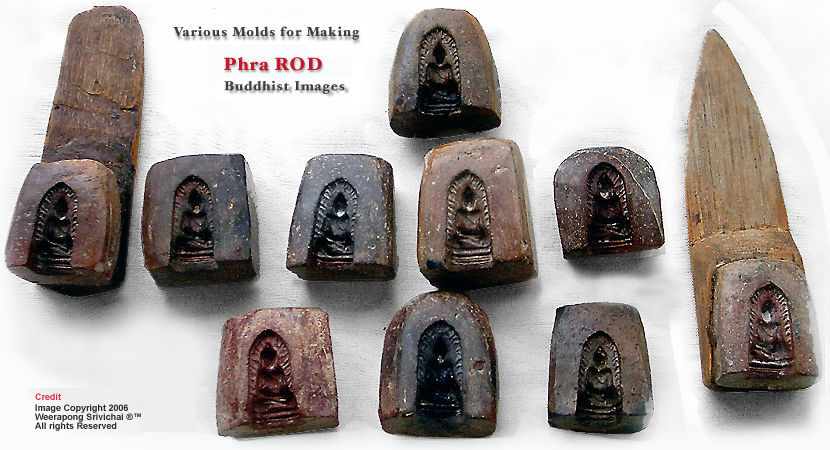
Thai amulets are typically made by four kinds of people. One of these are monks. Senior monks at the temple will facilitate and bless the creation of the amulets. Much of the time, monks will design the amulets and choose the materials to make them. Some monks are considered to have great spiritual power, so their amulets are highly valued.
Another kind of amulet maker is the artisan. These are lay people who are highly trained in amulet making. They often work under a senior monk and in partnership with a temple.
Some amulets are made by Ruesi or esoteric masters. These are spiritual figures who have their own following and practice a mixture of Animism and Buddhism. Their amulets have to do more with magical power (gaining wealth, physical protection, etc.) rather than reverence of the Buddha.

There are multiple recipes used to create Thai amulets. The traditional amulet is made from clay. They are created using sacred powders, such as flower pollen, herbs, crushed oyster shell, scraps of a monk’s robe, etc. Then, the powder is mixed with a binding agent like wax or sugarcane juice.
The other, more modern style of amulets are made from metal, tin or precious metals. Liquid metal is poured into a mold and then it dries, thus creating the amulet. This method is used for the “rian” style amulets. After the amulet finishes the mold process, there is one more step to complete: the blessing ceremony ( Pluk-sek in Thai).
This ritual consists of monks chanting mantras over the amulet to imbue it with holy power. Depending on the amulet, this process will be done for days, weeks, or even years. In addition to chanting mantras, the amulet is also sprinkled with holy water. Then, sometimes amulets are placed inside a protective casing.

My First Thai Amulet

One night back in April 2024, when I was living in Chiang Mai, I saw an amulet seller with a table set up outside of the temple. I had been living in Thailand for about a year already, and had encountered amulet sellers before, but had never bought one. I had always been cautious of it, as it wasn’t my culture and I wasn’t sure if I agreed with the practice of buying and selling spiritual items. But I had always admired Thai amulets, for their beauty and the powerful imagery they display.
On this night, I was called to look at them and I chatted with the amulet seller. I voiced my concern about purchasing amulets, and the seller told me not to worry. He told me that when you pay for an amulet, you are not buying it, but instead you are “renting” it. In fact, the word the Thais use when they talk about selling and buying amulets and other spiritual items translates to “rent”. They do this because it is believed that no one can ever truly “own” a buddha image.
So I felt put at ease, and immediately called to one amulet in particular. It was bigger than many of the others, colorful, and in a glass case outlined with gold. I asked the seller for the name of it and he told me it is “Chatukam Ramathep”.
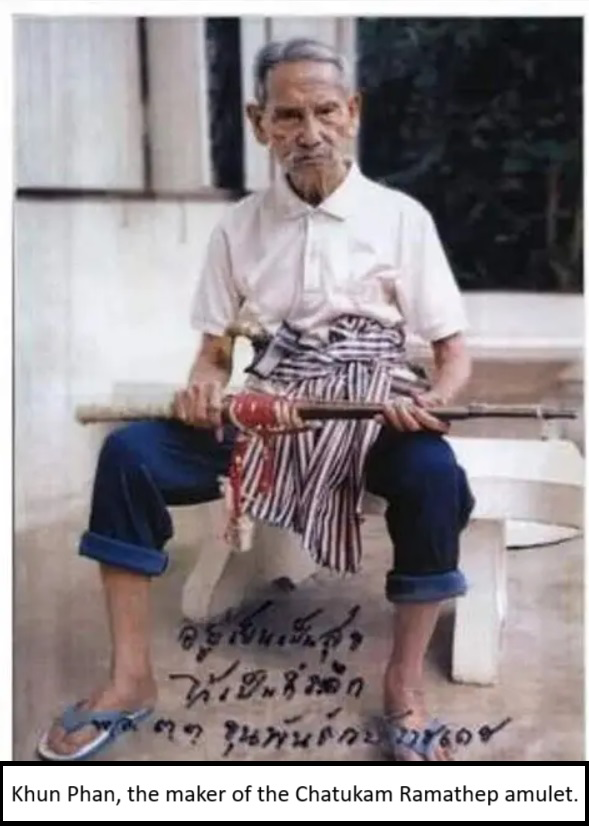
This amulet peaked in popularity in Thailand around 2006. At this time, you could see countless news stories and hear many tales of the Chatukam Ramathep amulet saving people’s lives or bringing its wearers great success. At the pinnacle, hundreds of temples all around Thailand were mass producing this amulet. Some of them were selling for hundreds of thousands of bhat or even millions.
The craze of this amulet can be exemplified in the April 2007 tragedy, where a woman was killed after being trampled by a stampede of eager Chatukam Ramathep fans. Over 10,000 people had camped outside of the temple, Wat Phra Mahathat in Nakhon Si Thammarat, so that they could be first in line to get the newly released Chatukam Ramathep amulet. The temple where this tragedy occurred, Wat Phra Mahathat, is the most significant shrine associated with Chatukam Ramathep.
The amulet was first created here in 1987 under the guidance of Police Maj. Gen. Khun Phan. Khun Phan is a legendary figure in modern Thai mythology. He was a highly respected police officer with a knowledge of the occult, and many Thais believe he possessed supernatural powers. (There is a famous Thai film from 2016 based on his life called by his own name, Khun Phan). Though the amulet had been around for nearly 2 decades, when Khun Phan passed away at the age of 104 in 2006, it became the catalyst for the Chatukam Ramathep craze.
At his funeral, over 200,000 people attended. After the woman died in the April 2007 tragedy, police began to limit the production of the amulet and its popularity began to gradually decline. By the time I bought my Chatukam Ramathep amulet in 2023, it was just another amulet, a shadow of its former self. While the amulet had been selling for as much as a million baht back in the early 2000s, I bought it for just 100 baht. It was actually one of the cheapest amulets on the seller’s table.
So now, who is Chatukam Ramathep, the figure who is prominently featured on my first Thai amulet? If you do some research, you’ll find it is unclear who exactly it is supposed to be. Many amulets feature figures who have an established identity, but when it comes to some figures like Chatukam Ramathep, there is a debate about who exactly he is.
The leading historical theory posits that he was a king or a prince of the Srivijaya Empire, which ruled from the 7th century to the 13th century AD and whose economy was almost solely based on maritime trade. The spiritual theory is that he is a god of wealth, protection, and justice. This belief is supported by the fact that the name “Ramathep” translates to “Celestial King” in the Sanskrit language. In Nakhon Si Thammarat, where this amulet was created, religious belief is a synthesis of Buddhism and Hinduism.
This is also generally true for the rest of southern Thailand. Here, many followers view Chatukam Ramathep as an avatar of the Hindu god, Vishnu. Vishnu is one of the most prominent gods in Hinduism’s giant pantheon and is the god of preservation. He is the protector of the universe. The reason some believe that is due to the fact that “Rama” is one of the avatars of Vishnu. Also, during the blessing ceremony of this amulet, sanskrit-based mantras are often used. The way that Chatukam Ramathep is depicted looks reminiscent of Hindu icons depicting Vishnu.
The last prevailing theory is that Chatukam Ramathep was made up by Khun Phan himself. It is said that, while in the middle of a murder investigation, Khun Phan had a dream where the god Chatukam Ramathep visited him and told him to create an amulet to honor him. In my opinion, this is the most plausible, because prior to the 1980s, there is no mention of Chatukam Ramathep in any Thai religious texts. This name only begins to appear around the time that the first amulet was created in 1987.
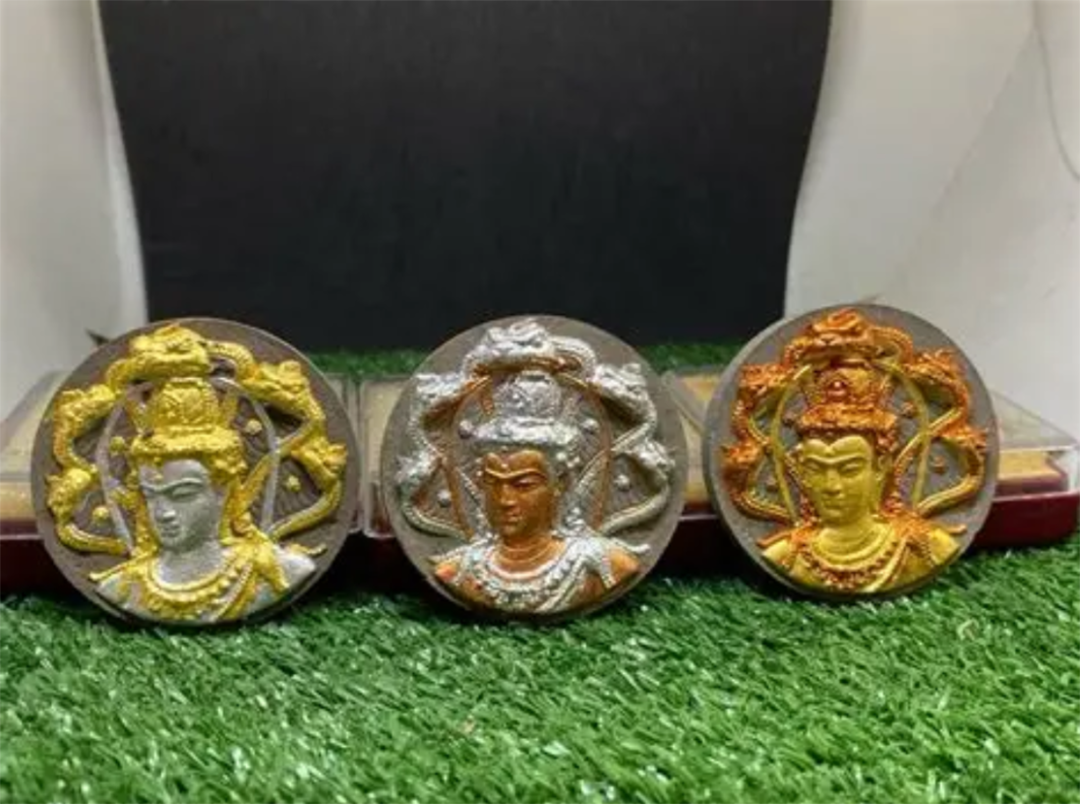
Overall, I think this was a great first amulet for me. Of course, because when I got it, it was very cheap. In fact, the cheapest on the table. Not only that, but also given its fame and popularity.
As a beginner, it is generally the case that you look towards the most notable entities in the field you are starting to pursue. If you are becoming interested in basketball, your first inspirations will be the greats, like Michael Jordan or Steph Curry. It makes sense. Lastly, I think, it is a great first amulet due to its aesthetic grandeur. The large size, all of the colors, the gold and glass casing, and the detailed artwork made this amulet catch my eye and fall in love with it.
Conclusion
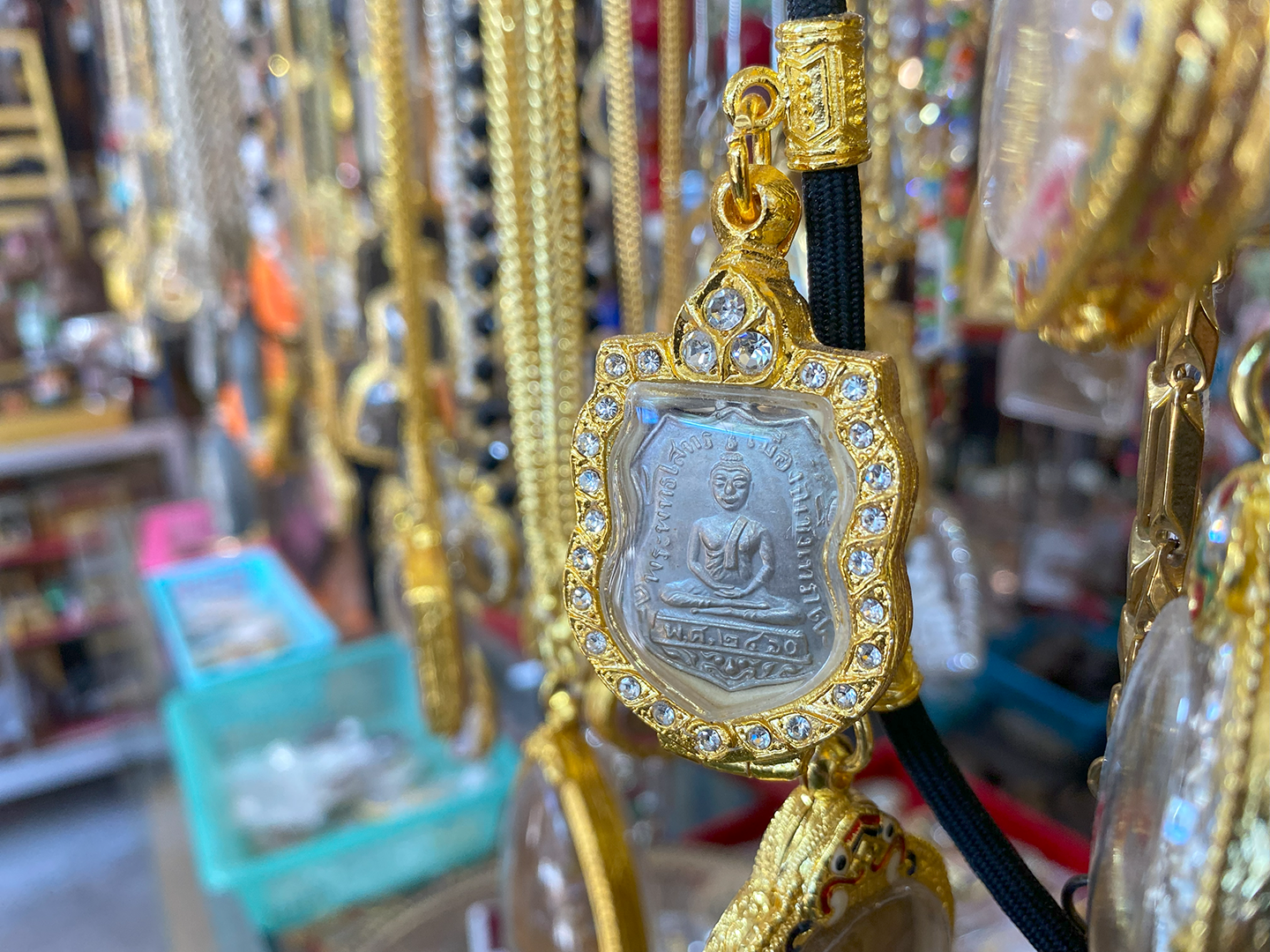
The world of Thai amulets is vast. It is estimated that there are over 100,000 unique types of them. Their history goes back over 1000 years. With this introduction to Thai amulets, you only got a taste of it. There are countless other stories to be told about these enigmatic cultural artifacts. Their significance in Thai culture cannot be understated. In the future, we will explore their esoteric side, and go into the relationship between Thai amulets and black magic.
